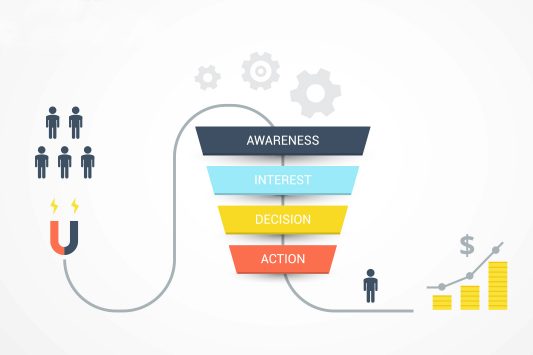Is there a disconnect between your marketing and sales teams?
Previously, the two entities had different roles within an organisation. Marketers were gatherers, in charge of nurturing relationships whereas sales were hunters, hunting for quick wins. However, since the hunter/gatherer days, times have changed.
In today’s consumer-driven environment, the two are interdependent, and need to work together towards the same goals in order to succeed.
Not convinced? Research by MarketingProfs has proven that businesses who align sales and marketing functions enjoyed 38% higher sales win rates .
The changing sales funnel
Prior to the digital era, the sales funnel was straight forward. Sales reps would approach leads, and persuade them to purchase.
But nowadays the sales process is not so simple. The customer’s buying journey is no longer a linear path, from awareness to sale. In fact, research has proven that a typical B2B customer encounters at least 6 touch-points before turning into a lead.
How come?
B2B buyers are consuming the same way at work as they do at home, replicating their B2C buying behaviours.
With a growing number of millennials in buying positions, buyers are becoming more digitally savvy and no longer ‘settling’. According to a recent Forrester report, 68% of B2B consumers will do their research prior to getting in contact with a company.
Thanks to the internet they can find out information about a company easier than ever before. Consequently, companies need to put more effort into providing interesting and engaging content.
As a result, it is no longer up to the sales team to contact customers, but on the contrary, it is down to the customers to contact companies. It might come to no surprise that in 2019 only 2% of B2B buyers are engaging with sales cold calling.
The role of the sales rep is changing. Sales is no longer about reaching out to customers, but about receiving them and providing them with an excellent customer experience.
But how do you get leads to contact your company? One answer – marketing.
How can marketing improve the sales funnel
- Make sure your website is impressive as well as credible
As we have noted above, 68% of B2B customers will do their research prior to getting in contact. So, it is up to you to ensure your company is looking the best it can online.
Put simply, if your website doesn’t sell your business concept well enough, the customer will not get in contact.
How can you sell your concept? Great imagery, understandable content and interesting case studies.
Videos on websites are also key to engaging your audience. According to Google, 70% of B2B buyers watch a video at some point during the buying process.
- Keep your social media and blogs up-to-date
Likewise, those B2B customers are likely to also go looking at your social media accounts, to gage what kind of company you are. Especially those millennials buyers.
However, there is nothing more off-putting than seeing social media pages or a blog that hasn’t been updated in months. Is the company even still in business?
The simple rule is, if you have resource to post engaging content, do it. If you don’t have the resources, you might be better off not being present on social media at all.
- Create your touch-points
If it takes at least 6 touch-points to generate a lead, make sure that those touch-points are readily available.
Touch-points can be your website and social media accounts, as well as any promotions, online and offline adverts, emails, direct mail, word-of-mouth, reviews etc.
The list could go on and on.
But critically, sales and marketing need to work together throughout the process, from deciding on shared goals to communicating clearly and continually adapting the sales funnel to suit the market.
